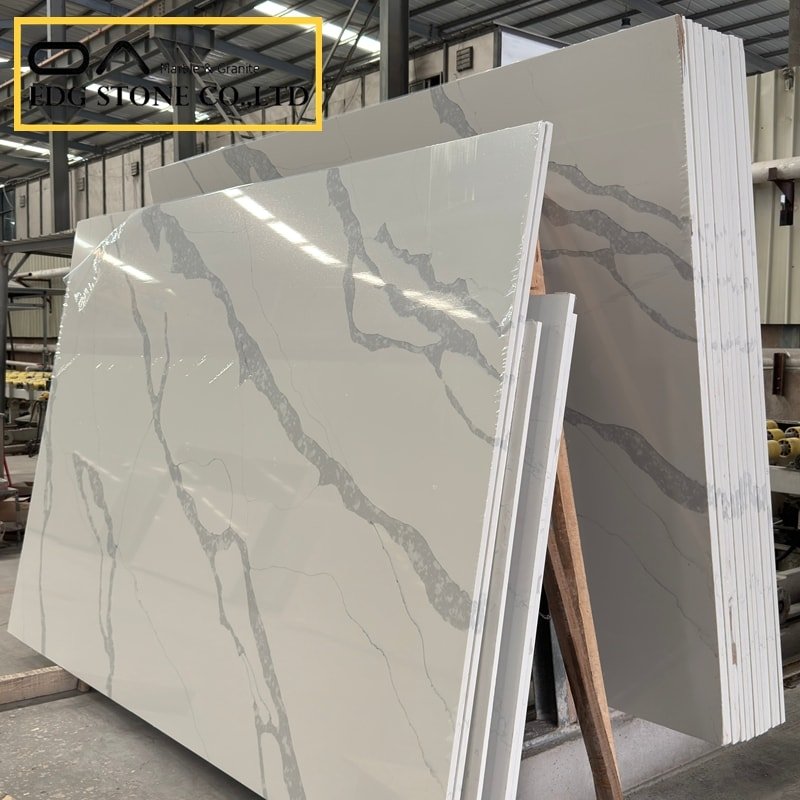
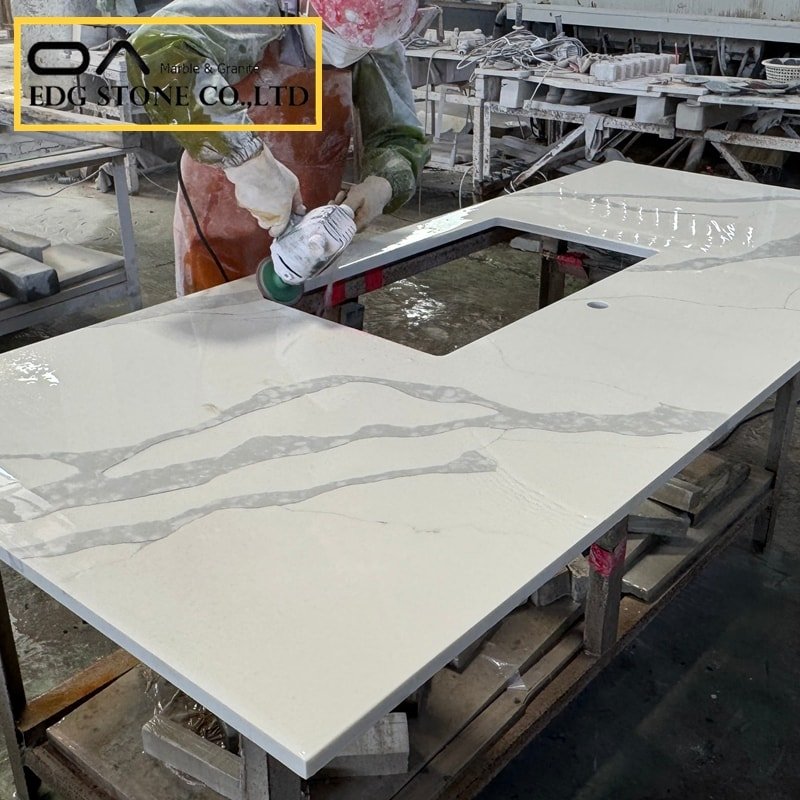
What this page answers (short):
Table of Contents
Toggle- 1. What is a quartz stone slab? — composition & how it’s made
- 2. Where quartz slabs are best used — practical applications
- 3. Quartz vs Granite — pros and cons (practical comparison)
- 4. Quartz slab grades, quality indicators, and buying tips
- 5. Cost drivers & how to estimate value
- 6. Safety, regulations, and the industry pivot (critical — 2024–2025)
- 7. Sustainability and alternatives
- 8. FAQ — Google hot searches (5 Q&A)
What quartz slabs are made of, where they perform best (kitchens, baths, commercial), pros & cons vs granite, how quartz is graded and specified, and what recent regulations and safety guidance mean for buyers and manufacturers.
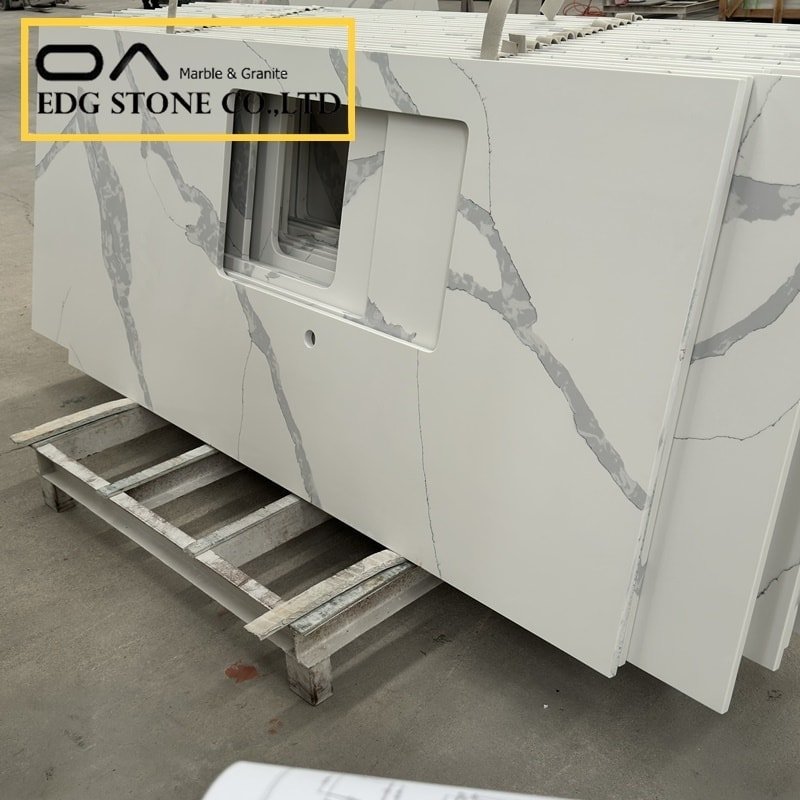
1. What is a quartz stone slab? — composition & how it’s made
Definition (plain): A “quartz slab” for countertops is an engineered surfacing product made primarily from crushed natural quartz (the mineral SiO₂) combined with polymeric resins, pigments, and other additives, then compacted and cured into large slabs. The engineered mix is usually 85–95% quartz by weight, the remainder being resin binders and color agents that create the slab’s appearance and make it non-porous.
Manufacturing highlights (short):
Raw quartz (ground to a fine aggregate) is blended with polyester or epoxy resins, pigments, and sometimes recycled material.
The mixture is vibrated and compressed under vacuum to remove air, then heat-cured into slabs.
Surface finish (polished, honed, leathered) and edge profiles are fabricated afterward.
Why the blend matters: The resin content controls flexibility and non-porosity; the quartz fraction determines hardness and scratch resistance. Higher quartz content typically equals better hardness and less flex, but can raise material cost.
2. Where quartz slabs are best used — practical applications
Quartz slabs are prized because of the combination of durability, consistent appearance, and low maintenance. Typical and high-value use cases:
Kitchen countertops: Most common use — stain resistance, food-safe surfaces (when properly certified), and minimal sealing required.
Bathroom vanities & shower surrounds: Low porosity reduces mold and staining risk. Note: Prolonged, high-humidity installations should follow manufacturer guidance for seams/backsplashes.
Commercial counters & reception desks: Predictable color and uniformity make quartz a favorite for hospitality and retail.
High-traffic horizontal surfaces: Bar tops, islands, and work surfaces where stain/scratch resistance matters.
Vertical cladding & wall panels: When manufactured in thicker or reinforced panels, quartz can be used architecturally (but weight/cost considerations apply).
Limitations: Not ideal for direct contact with very high heat (hot pans can cause resin damage) and for outdoor horizontal use in strong UV climates unless A UV-stable product is specified.
3. Quartz vs Granite — pros and cons (practical comparison)
Quartz — pros
Nearly non-porous: minimal sealing, easier cleaning.
Wide, consistent color/pattern range (manufactured aesthetics).
High surface hardness and scratch resistance.
Predictable slabs and tighter color matching across batches.
Quartz — cons
Resin can burn or discolor with sustained high heat (no trivets directly).
It can be more expensive than entry-level granite depending on the grade.
Some engineered quartz contains high crystalline silica content in production — worker safety considerations (see section 6).
Granite — pros
Natural variability and unique veining are prized for high-end aesthetics.
Superior heat resistance compared with resin-based quartz.
It can be less expensive for some local varieties.
Granite — cons
Porous: usually requires periodic sealing.
Natural fissures may require more patching or edge care.
Color matching and consistency across slabs are less predictable.
Bottom line: Choose quartz when low maintenance, consistent appearance, and stain resistance are priorities. Choose granite when heat resistance or natural stone aesthetics are the focus.
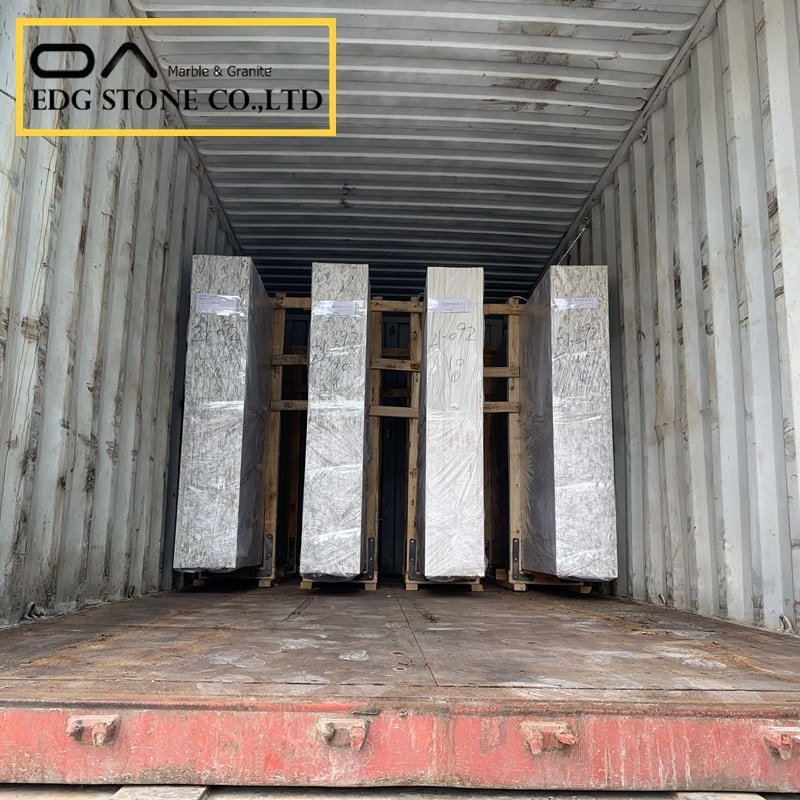
4. Quartz slab grades, quality indicators, and buying tips
Common grade categories (industry practice):
First-choice / Grade A / Premium: Highest quartz content, finest control of aesthetics, consistent slabs, best durability, and warranty.
Commercial grade: Used for visible surfaces in commercial projects — balance of cost and performance.
Second choice / Remnant / B-grade: Slightly lower quartz content, more visual defects, used for backsplashes, non-critical surfaces.
Quality checks before purchase:
Quartz percentage — ask the supplier for the typical quartz/resin ratio; higher quartz % generally means a harder surface.
Sample verification — verify the slab in person under your site lighting.
Finish & edge control — inspect seams, edge polish, and edge bonding.
Warranty & certifications — NSF/ANSI 51 for food-contact testing, product warranty length, and manufacturer safety policies.
Supplier compliance — given industry regulation changes, confirm the supplier follows local occupational safety laws and provides documentation on silica handling.
Long-tail, purchase-intent keywords you can use in product pages:
“buy quartz slab manufacturer”
“quartz countertop factory wholesale”
“order quartz slabs bulk supplier”
“quartz slab grade A factory direct”
“wholesale quartz slabs for commercial projects”
5. Cost drivers & how to estimate value
Major cost factors
Grade & quartz percentage — premium A-grade costs more.
Finish & thickness — 20mm vs 30mm vs 40mm, and custom edge profiles increase price.
Color/pattern complexity — veined or rare patterns are priced higher.
Fabrication & installation — cutouts, seams, complex islands, and installation distance add labor costs.
Region & supply chain — import duties, shipping, and recent regulatory controls can shift prices significantly.
How to estimate: Ask for per-square-foot slab price (material only), plus a separate fabrication & installation quote. For many markets, installed quartz countertops range widely; obtain at least 3 quotes and verify warranty/service terms.
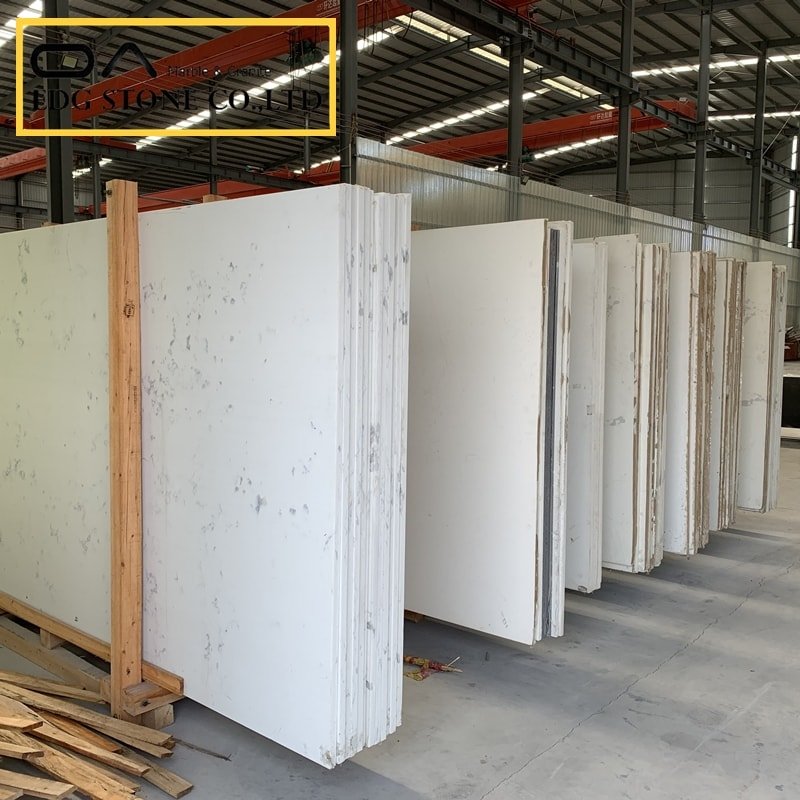
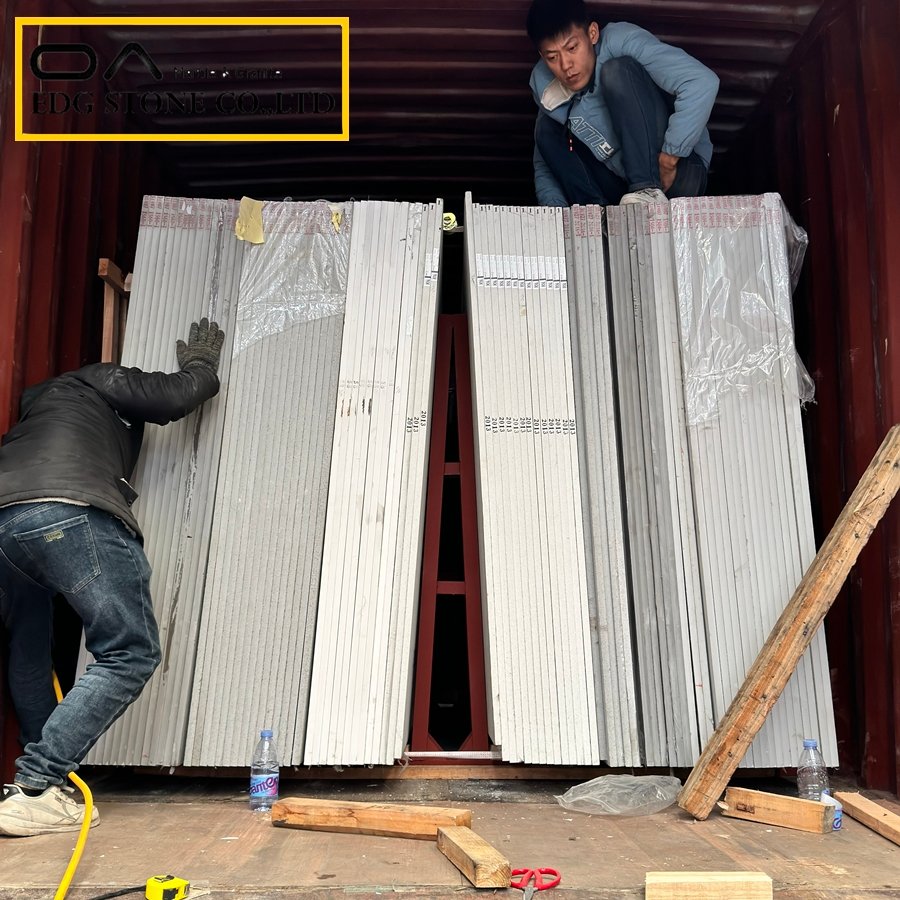
6. Safety, regulations, and the industry pivot (critical — 2024–2025)
Why this matters: Fabrication of engineered quartz releases respirable crystalline silica (RCS) dust during cutting, grinding, and polishing. Long-term exposure causes silicosis and other lung diseases. Workplace controls are essential.
Notable regulatory developments
Australia: In response to a public health crisis among engineered-stone workers, Australian WHS Ministers agreed to ban the use, supply, and manufacture of engineered stone from 1 July 2024, and later went on to restrict importation — a landmark regulatory move that is already reshaping global suppliers and compliance requirements. Buyers and manufacturers with Australian exposure must follow the ban and follow-on import controls.
United States: OSHA and NIOSH have increased focus and inspection initiatives around respirable crystalline silica in countertop fabrication, with guidance for dust controls, wet cutting, local exhaust ventilation, and respiratory protection. Expect stricter enforcement and buy-side documentation requests in many large markets.
What should procurement teams do now?
Request supplier silica safety & compliance statements and evidence of safe fabrication practices (wet cutting, dust collection, medical surveillance for workers).
Prefer suppliers who publish third-party safety audits or operate closed-loop dust control systems.
Factor potential trade/regulatory risk into lead-time and compliance checks—some markets may restrict certain engineered products.
7. Sustainability and alternatives
Recycling & circularity: Some manufacturers now include post-consumer/recycled content and offer slab take-back programs. Ask for the recycled percentage and third-party verification.
Low-silica alternatives: For buyers worried about future regulation, consider:
Low-silica sintered or ceramic slabs (porcelain large-format slabs) — very low RCS in production and strong outdoor/UV performance.
Dekton / sintered stone variants — different manufacturing processes; research supplier credentials and lifecycle data.
Natural stone (granite, marble) from certified quarries — requires sealing but has a different regulatory profile.
8. FAQ — Google hot searches (5 Q&A)
FAQ (visible text) — keep these exact because we will mirror them 1:1 in the structured JSON-LD below.
What is a quartz slab made of?
A quartz slab is usually 85–95% ground natural quartz combined with polymeric resins, pigments, and additives; the mixture is compacted and cured into a stable, non-porous slab.Is quartz better than granite for kitchen countertops?
Quartz is lower maintenance and less porous than granite, offering predictable color and better stain resistance; granite offers superior heat resistance and unique natural patterns—the choice depends on priorities.Are quartz slabs safe for food preparation?
Yes, when produced by reputable manufacturers and certified to relevant food-contact standards (e.g., NSF), quartz surfaces are safe for food prep and are easier to sanitize due to low porosity.How do quartz slab grades differ?
Grades vary by quartz percentage, manufacturing quality, and aesthetic control: Grade A/premium slabs have higher quartz content, tighter color control, and longer warranties; second-choice slabs are lower cost with more visual variation.What recent regulations affect engineered quartz manufacturing and import?
In some jurisdictions (e.g., Australia), engineered stone use and manufacturing have been banned due to silicosis risks (ban effective July 1, 2024), and many regulators (OSHA/NIOSH) have increased inspections and guidance for silica controls—buyers should verify supplier compliance documentation.
9. Semantic closed-loop content block
Semantic closed-loop content block — How / Why / What / Options / Considerations
How: How quartz delivers value — engineered composition (high quartz content + resin), compression curing, and controlled aesthetics produce durable, low-maintenance surfacing suitable for kitchens, bathrooms, and commercial areas.
Why: Why buyers choose quartz — predictability (color/match), near-non-porosity (less sealing), and surface performance (scratch/stain resistance) make it a lower-lifecycle-cost alternative to some natural stones.
What: What to check before buying — slab grade, quartz percentage, finish type, resin/adhesive heat limits, supplier safety & compliance records, and warranty terms. Ask for third-party certifications (NSF, ISO) and evidence of safe fabrication practices.
Options (detailed): Option A — Premium Grade (A) quartz for visible kitchens and islands; Option B — Commercial grade for hospitality projects balancing cost & durability; Option C — Low-silica sintered/porcelain slabs for outdoor or high-UV needs.
Considerations (detailed): Regulatory risk (engineered stone bans or import controls), worker safety in the supply chain, and lifecycle footprint: factor in fabrication safety practices and end-of-life recyclability when choosing suppliers.
10. Focus Keyword, SEO tags
Long-tail purchase intent keywords (3–5):
Buy quartz slab manufacturer wholesale
quartz slab factory direct price per square foot
Grade A quartz slab supplier for commercial projects
where to buy quartz slabs in bulk manufacturer
quartz slab wholesale factory export
50 SEO tags (comma-separated — mix of product & purchase intent):
quartz stone slab, what is quartz slab, what is quartz stone good for, slab stone quartz, quartz slab grades, buy quartz slab manufacturer, quartz slab factory, wholesale quartz slabs, quartz countertops pros and cons, quartz vs granite, benefits of quartz countertops vs granite, granite vs quartz countertops pros and cons, advantages of granite countertops, pros and cons of quartz countertops, engineered quartz composition, quartz slab price, quartz countertop cost per sq ft, grade A quartz slab, commercial grade quartz, kitchen quartz countertop, quartz vanity top, quartz backsplash, quartz slab installation, non-porous countertop, low maintenance countertops, quartz slab warranty, NSF certified quartz, silica safety engineered stone, regulated engineered stone, quartz slab suppliers, quartz slab exporter, quartz slab manufacturer China, factory direct quartz, buy quartz slabs bulk, wholesale quartz countertops, quartz slab care, quartz slab finish, polished quartz slab, honed quartz slab, leathered quartz surface, quartz slab sustainability, recycled quartz slab, sintered stone alternative, porcelain slab vs quartz, quartz slab weight per sq ft, quartz slab thickness options, quartz slab edge profiles, quartz slab seams, quartz slab color options, how quartz is made, quartz slab fabrication.
